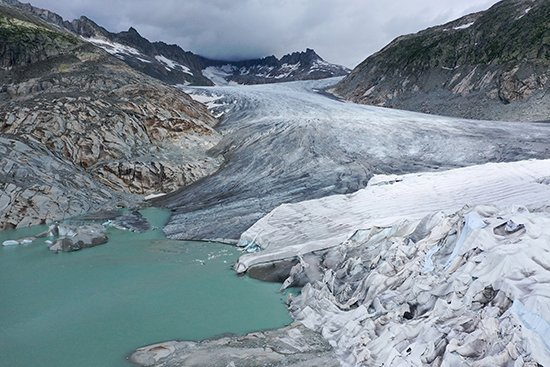氣候危機(jī)威脅眾多行業(yè),但對(duì)這個(gè)行業(yè)來(lái)說(shuō)是機(jī)遇

|
許多人將冰川融化及冰川盆地的出現(xiàn)看成壞事,,而瑞士研究者則在其中看到了水力發(fā)電和淡水存儲(chǔ)的機(jī)遇。 上周三發(fā)表于《自然》雜志(Nature)的這項(xiàng)研究,,目前還主要停留在理論層面,。該研究對(duì)全球185,000座冰川進(jìn)行了考察,并從環(huán)境、技術(shù)及經(jīng)濟(jì)因素出發(fā),,對(duì)這些地方建造水壩進(jìn)行水力發(fā)電及淡水存儲(chǔ)的可行性進(jìn)行了評(píng)估,。如果上述冰川均得到開(kāi)發(fā),其產(chǎn)生的電能將相當(dāng)于2015年全球總用電量的7%或全球水壩發(fā)電量的35%,。 “我們不可能在每座冰川都建造水壩,,這種做法既不可持續(xù),也不可取,?!弊髡邚?qiáng)調(diào)說(shuō)。這種浩大工程在虛擬土木工程研究方面的價(jià)值,,以及“對(duì)國(guó)家能源供應(yīng)潛在的巨大貢獻(xiàn)不容忽視,,尤其是在亞洲高山地區(qū),”這里由于高山聳立,,冰川覆蓋廣泛,,又被稱(chēng)為地球“第三極”。 除了水力發(fā)電潛力巨大,,作者還發(fā)現(xiàn),,冰川盆地可以容納當(dāng)前冰川徑流48%的水量。這對(duì)干旱地區(qū)意義尤為重大,,它可以用來(lái)儲(chǔ)備淡水,,以應(yīng)對(duì)未來(lái)的水資源短缺。 185,000座冰川中,,1,000座的發(fā)電潛力占到了總量的三分之一,,其中最大的十個(gè)可以建造水壩的冰川位于美國(guó)、中國(guó),、加拿大和尼泊爾,。 長(zhǎng)期以來(lái),研究者一直預(yù)測(cè)水電行業(yè)的成本將會(huì)上升,,受極端天氣和裝機(jī)容量下降的影響,,這一擔(dān)憂(yōu)已經(jīng)成為現(xiàn)實(shí)。 而大型水電項(xiàng)目在立項(xiàng),、融資,、開(kāi)工前,往往都會(huì)經(jīng)歷大量的論證,,也會(huì)聽(tīng)到很多反對(duì)聲音,,因而研究者在挑選壩址時(shí)首先考慮的不是營(yíng)收潛力最大化,而是最小化對(duì)環(huán)境的影響,。該團(tuán)隊(duì)對(duì)各處的建造成本進(jìn)行了粗略預(yù)估,,評(píng)估項(xiàng)目包括大壩壩體,、發(fā)電站、運(yùn)營(yíng)及電力輸送,。根據(jù)測(cè)算,,60%水力發(fā)電站的理論峰值生產(chǎn)成本低于50美分/千瓦時(shí)。 未參與該研究的哥倫比亞水務(wù)中心(Columbia Water Center)的主任厄普曼努·拉爾表示:“不確定性很高,,而且從政治上講,,大多數(shù)國(guó)家都不太可能允許建造新的水庫(kù)?!保ㄘ?cái)富中文網(wǎng)) 譯者:馮豐 審校:夏林 |
Many look at the world’s melting ice and see glacier basins as half-empty. Swiss researchers see them as half-full of opportunities for hydropower and freshwater storage. The largely theoretical study, published at last Wednesday in the journal Nature, examined 185,000 glaciers around the world and determined where environmental, technical and economic factors would allow for the building of dams to harness both the power of glacier melt and the value of water itself. If all such sites were tapped, the amount of electricity generated would equal 7% of the world’s total electricity consumption in 2015, or 35% of the world’s output from dams. “Building a dam at every glacier location is neither realistic, nor sustainable, nor desirable,” the authors emphasize. The value in such an ambitious exercise in virtual civil engineering is worth considering given, the potentially “important contributions to national energy supplies, particularly in High Mountain Asia,” a region with so much ice it’s informally called the Third Pole. In addition to the massive amount of hydropower, the authors found the glacier basins could hold a combined 48% of the runoff from current glaciers. That’s especially important in arid regions, where such reserves serve as a hedge against future water scarcity. Almost a third of the potential power comes from 1,000 of the 185,000 sites, and the 10 largest glacier basins that could be dammed are in the U.S., China, Canada and Nepal. The hydropower industry is already facing long-predicted higher costs, as operators expect to struggle with both extreme weather and falling capacity in the coming years. Large hydropower projects, however, are rarely planned, financed and built without considerable debate and opposition, which is why the researchers selected sites with an eye towards minimizing environmental impact instead of maximizing potential revenue. The team generated rough cost estimates for each location that included the dam itself, power stations, operations and transmission to the nearest grid. About 60% of the theoretical maximum of plants could have production costs below 50 cents a kilowatt-hour. “The uncertainties are high,” said Upmanu Lall, director of the Columbia Water Center who was not involved in the study, “and it is rather unlikely that, politically, new reservoir construction will be allowed in most countries.” |













